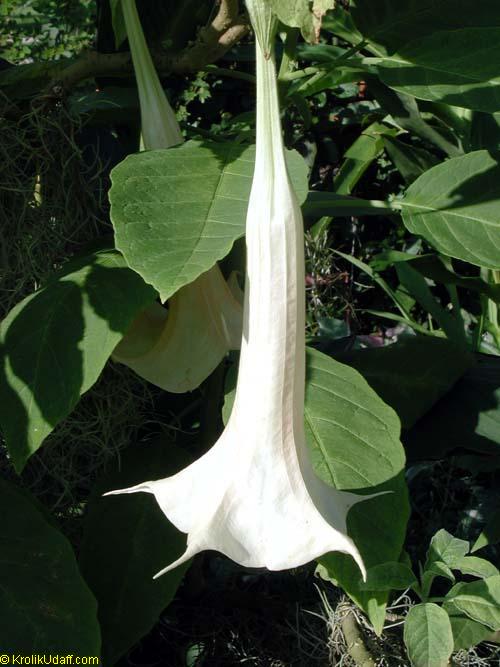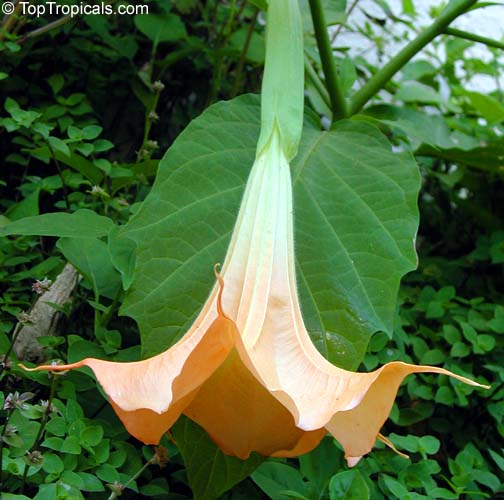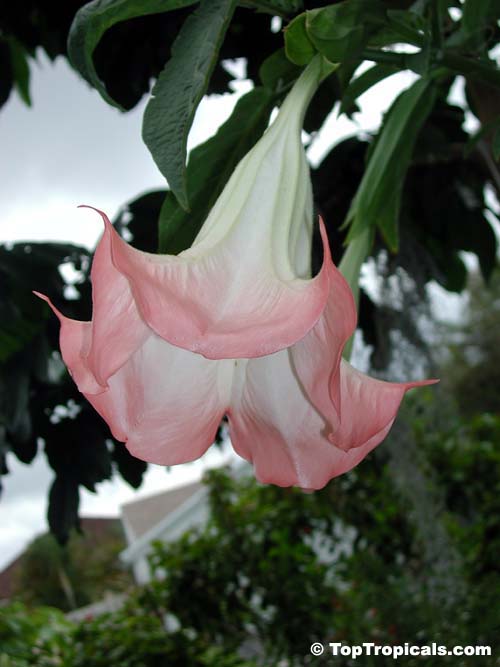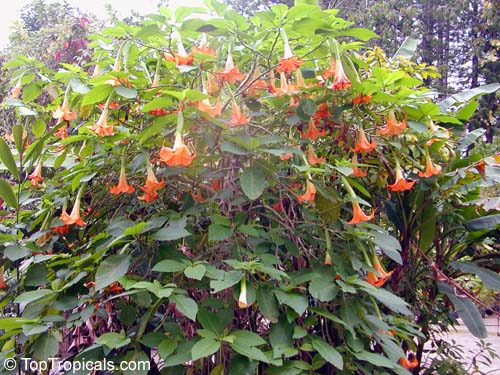Special plants - Medical uses, culinary recepies, psychoactive effects, etc.
| Psychotropic | Medicine, Culinary, cooking, drinks |
| Datura Brugmansia Iresine Leonotis Nymphaea Kava Morning Glory |
Hibiscus Furcellatus
|
 |
Datura (Purple Horn-of-Plenty, Jimpson Weed,Devil's Weed)
"Datura produce unusual, distinctive walnut sized seed pods covered with spikes. It has been used in every area in which it is known, in rites of passage and in diverse forms of Shamanism. Its psychoactive properties are extraordinary, and there is certainly no plant more associated with magic and Witchcraft than the Daturas. One of the usual modalities in the Datura experience is that of mystical flight--an out-of-the-body sensation. A very powerful Shamanic tool, it was sometimes said to take years of navigating the spiritual worlds to be ready to learn from Datura and in many cultures its use was forbidden to all but the high priests". ( Source: Shamanic Extracts) "The leaves, stem, root and fruits of Datura contain a battery of tropane
alkaloids, the most potent of which are atropine, hyoscyamine and scopolamine.
These alkaloids affect the central nervous system, including nerve cells of the
brain and spinal cord which control many direct body functions and the behavior
of men and women. They may also affect the autonomic nervous system, which includes
the regulation of internal organs, heartbeat, circulation and breathing. One autonomic
response of atropine is the dilation of pupils, once considered to be a beautiful
and mysterious look in Italian women. In fact, belladonna means "beautiful
lady," so named because sap from the closely related belladonna plant (Atropa
belladonna) was used as eye drops to dilate the pupils. The action of tropane
alkaloids at the cellular level is complex. It is summarized by R.E. Schultes
and A. Hofmann in the The Botany and Chemistry of Hallucinogens (1973) and in
Medical Botany by W.H. Lewis and M.P.F. Elvin-Lewis (1977). Tropane alkaloids
are found in many other poisonous plants, including henbane (Hyoscyamus niger),
pituri (Duboisia spp.), and mandrake (Mandragora officinarum), all of which were
used extensively in witches' brews and folk medicines. Without getting into complicated anatomy and physiology, one nerve cell (neuron) connects to an adjacent neuron by a long extension called an axon. The axon branches into axonal endings, each of which attaches to the adjacent neuron at a synaptic knob filled with acetylcholine. The minute gap or synaptic cleft within this knob is only about 0.02 micrometers. As a nerve impulse (wave of depolarization or action potential) reaches this gap, acetylcholine diffuses across the synaptic cleft and activates the adjacent neuron. Acetylcholine in the synaptic cleft is deactivated or broken down by the enzyme acetylcholinesterase, thus shutting off the action potential. Organophosphate insecticides, such as malathion and parathion, bind to active sites on this enzyme, thus preventing the normal shut down of nerve impulses and destroying the nervous control of insects. Nerve gasses developed during World War II have a similar effect on the nervous system. Gulf War soldiers carried an atropine syrette to counter the possible effects of nerve gas. Depending on the dosages, several tropane alkaloids of Datura (when absorbed together) may have synergistic properties resulting in extreme hallucinations, delirium and death. Since the alkaloids are fat soluble they are readily absorbed through the skin and mucous membranes. Volumes have been written about the uses and properties of Datura in the Middle Ages. Most of the uses involved the consumption of potions or concoctions made from various parts of the plant. During ancient religious rituals in India, seeds were eaten by priests to induce
hallucinogenic, prophetic and oracular states. European priests apparently drank
Datura for the same reason. Some authorities believe the intoxicating smoke inhaled
by Greek priests over 2,000 years ago at the Oracle of Delphi was Datura. Thieves
in India and Europe used Datura for centuries as "knockout drops" to
rob their stupefied victims. The plant was also known in China, where a law prohibited
mixing it with wine and other drinks. Probably the best known use of Datura by several North American Indian tribes was the puberty ceremonial dances involving the drinking of a "toloache" (Datura) infusion by young boys preparing to enter manhood. The ceremonies generally involved wild erratic dancing, varied hallucinations, and finally unconsciousness. Datura alkaloids even have modern medicinal uses. The fat solubility of tropane alkaloids is employed in a remarkable remedy for seasick mariners called Transderm Scop®. A small, medicated disc resembling a circular Band-Aid® releases small amounts of scopolamine into the bloodstream for up to 3 days. The anti-nausea effects of scopolamine may relate to its anticholinergic action on the central nervous system, which results in inhibition of the vomiting reflex". Source: Wayne's Word
|
|
|
Brugmansia spp. - angel trumpet
From The
Encyclopedia of Psychoactive Substances: "Often called the 'tree Daturas', Brugmansia are now recognized by botanists as deserving of a distinct taxonomic status within the family Solanaceae. All species of the genus are native only to South America. The plant grows along the Andean and Pacific fringe of the continent from Colombia down to southern Peru and the middle of Chile. The major alkaloid present in these species is scopolamine but hyoscyamine and atropine are also present. Hallucinations And Aphrodisiac Effects Native peoples drink hot and cold infusions of Brugmansia leaves and flowers, and also mix its ground seeds into their fermented maize beer (chicha). A traveller in nineteenth-century Peru gives the following description of the effects of such a psychoactive drink on an Indian man who was seen to be: 'falling into a heavy stupor, his eyes vacantly fixed on the ground, his mouth convulsively closed and his nostrils dilated. In the course of a quarter of an hour, his eyes began to roll, foam issued from his mouth, and his whole body was agitated by frightful convulsions. After these violent symptoms had passed, a profound sleep followed for several hours' duration and when the subject had recovered, he related the particulars of his visit with his forefathers. He appeared very weak and exhausted.' As well as using the plant as a way of communicating with the ancestors, native peoples have sought its aid in prophecy, divination, witchcraft and medicine and a number of less spiritually orientated pursuits such as finding gold and ancient graves, which, if found, could be plundered for treasure. So prevalent was this last activity in Peru that two of the local plant names cited above (yerba de huaca and huacahaca) actually mean 'plant of the tomb'. Like all of its solanaceous relatives that possess psychoactive properties, Brugmansia species have their sinister applications. Among the pre-Conquest Chibcas of Colombia a concoction of Brugmansia, tobacco and maize beer was given to slaves and wives of dead kings in order to put them in a deep narcotic state so that they could be buried alive with their masters and husbands. An account from 1589 details just such an occurrence: a dead chief was accompanied to the tomb by his women and slaves, who were buried in different layers of earth ... of which none was without gold. And so that the women and poor slaves should not fear their death before they saw the awful tomb, the nobles gave them things to drink of inebriating Tobacco and other leaves of the tree we call Borrachero, all mixed in their usual drink, so that of their senses none is left to foresee the harm soon to befall them. Schultes and Hermann have identified the species in question to be B. aurea and B. sanguinea. It seems ironic that both those that lay dead in the tombs and those that plundered and looted such graves were there because of Brugmansia and its psychoactive effects. Yet perhaps it was also a kind of sympathetic magic on the part of the grave robbers. Other Colombian peoples are also known to have had similar practices; some graves belonging to the Quimbaya culture of Cauca Valley have been discovered to contain a large number of disc-shaped clay spindle whorls (items used in spinning thread) decorated with representations of what appear to be the intoxicating flowers of Brugmansia or Datum. Brugmansia is also sometimes used in conjunction with tobacco. The present-day Tzeltal Indians of Mexico smoke the dried leaves of B. suaveolens with Nicotiana rustica in order to obtain visions that will indicate the cause of various diseases. According to Peter De Smet, the expert on the ritual use of enemas, the Jivaro Indians of eastern Ecuador and Peru (most famous for their unique contribution of head shrinking) used species of Brugmansia in a decoction which was taken as an enema by their warriors 'to gain power and foretell the future'. A Jivaro boy as young as six may take Brugmansia or another psychoactive preparation such as ayahuasca under the supervision of his father in order to create an 'external soul' which is a psychic 'organ' capable of communicating with the ancestors through visionary experiences. Among the Jivaro, children who suffer from what are currently described as 'behavioural problems' would sometimes be given a drink of Brugmansia and be admonished by the parents whilst the ancestors were present (due to the effects of the drink). The plants are widely traded for both their psychoactive properties and ornamental value. The Kamsa and Ingano people of the Sibundoy Valley in the Columbian Andes distribute a number of species throughout the Amazon. The cultivation of the plant is supervised by shamans with special knowledge of their botany and pharmacology. In Sibundoy, as a rule, the use of Brugmansia for its psychoactive effects is restricted to shamans who drink it either in water or alcohol and see terrifying visions of jaguars (the most important shamanic animal in large parts of South America) and snakes. To withstand the assault of such powerful images one needs the psychological strength that is the prerogative of the shaman. Other psychoactive plants of the Solanaceae family are said to have a fragrance so strong that it can cause narcosis or sleep in those who inhale it, and there is a similar belief concerning the Brugmansia. It is said that the scent of the flowers causes erotic dreams and for this reason it is incorporated into love magic". Translation from German: All plants of the different Brugmansia kinds contain so-called Tropanalkaloide,
in particular scopolamine, partly also atropine, as well as some further in smaller
concentration, like e.g.. Hyoscyamin. The seeds of the plant contain the highest
quantity of alkaloid (main Hyoscyamin ), in addition, in sheets and blooms occur
a sufficient quantity. Preparation and dosage: Also possible the sheets are to be smoked, whereby only a subtler effect Effect and side effects: "overdosing can lead during initial excitation to dance rage, raving Also, species of Brugmansia have been reported to be used during ritual practices for magical and curative purposes. |
 |
Iresine herbstii (Beefsteak Plant, Chicken Gizzard, Blood leaf) "Iresine herbstii Hook. (Amaranthaceae) is used in the northern Peruvian Andes for magic-therapeutic purposes. The traditional healers use with the ritual aim to expel bad spirits from the body. Furthermore, I. herbstii was used in association with other plants, such as Trichocereus pachanoi Britt. et Rose, for divination, to diagnose diseases, and to take possession of another identity. The tests considered to evaluate the central nervous system activity were: locomotor activity, motor coordination, pentobarbital-induced sleep, stereotyped behaviour, catalepsy, nociceptive assays and transmurally stimulated guinea-pig ileum". |
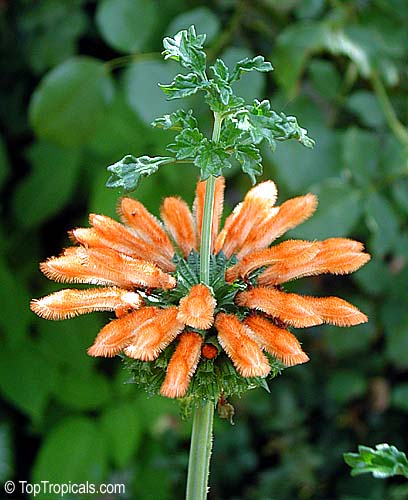 |
Leonotis leonurus (Wild Dagga, Lions Tail) Wild Dagga is smoked or made into a medicinal tea by the Hottentot tribe of South Africa. Because of its euphoric effects, Wild Dagga is often referred to as a Cannabis substitute. Leonotis leonurus (Wild Dagga, Lion's Tail) species is also used in Eastern medicine as euphoria, purgative, and vermifuge. Source: Shamanic Extracts |
|
Nymphaea Caerulea (Blue Lotus, Sacred Blue Lily of the Nile) Nymphaea Caerulea (Blue Lotus or Sacred Blue Lily of the Nile) was the most
sacred plant of Ancient Egypt, prized above all others. It was was worshipped
as a visionary plant and was a symbol for the origins of life. It was frequently
depicted in works of art, where it is most often shown in party and other social
scenes, and sometimes in scenes of sexual debauchery. The flowers were noted for
their delightful perfume, suggestive of the sweat of Ra; 'A divine essence, for
bringing euphoria, heightened awareness and tranquility'. The Blue Lily was also
a symbol of creation, and was according to legend the first object to emerge from
oceanic chaos. Though exceedingly rare in the wild today it is thought to have
been widespread across Ancient Egypt, where its psychoactive properties were apparently
well known. |
|
|
From The Encyclopedia of Psychoactive Substances: "Kava is the name given by Pacific islanders to both Piper methysticum, a shrub belonging to the pepper family Piperaceae, and the psychoactive beverage made from it. P. wichmannii is now seen to be a wild variant of P. methysticum rather than a genuinely distinct species. P. methysticum is a hardy perennial which often grows up to three meters or more. The rootstock or stump contains the psychoactive substances. Its psychoactive constituents are called kavalactones and, despite claims to the contrary, there seem to be no psychoactive alkaloids in kava. The roots and stumps of kava are prepared by pounding, chewing or grinding them and soaking them in cold water. Drinking the resulting infusion has a soporific and narcotic effect. More specifically the user typically feels a state of mild euphoria and tranquillity. The muscles relax and the user remains in control; outbursts such as those precipitated by alcohol are alien to the kava experience. Some users report an increased mental clarity under its influence. As its effects go on its soporific qualities come to the fore and the user falls asleep. Occasionally drinkers may experience mild side effects such as double vision. Excessive drinking of kava has significant effects on the health particularly skin complaints and loss of appetite. Unlike betel (also of the pepper family) which became a widely popular stimulant in the Pacific, kava was not imported by man but rather discovered by him on his arrival in the region. Current research suggests that it may have first been domesticated less than 3,000 years ago in Vanuatu (which used to be called the New Hebrides), a group of islands in eastern Melanesia. The use of kava seems then to have diffused both westward to New Guinea and part of Micronesia and eastward into Fiji and then Polynesia. The archaeology of the region has not, as yet, revealed much about the origins and early history of kava use. Part of a fossilized stem, which can only tentatively be suggested as belonging to the kava plant, was discovered at the Talepakemalai site on Eloaua Island north of the Bismarck Archipelago of Papua New Guinea. It was found in association with a highly decorated style of pottery known as Lapita. The Lapita peoples are thought to be the ancestors of the modern Polynesians and their pottery vessels to be early examples of bowls used in drinking kava. However, things do not fit that neatly together as Lapita artifacts have been found in areas outside the kava-drinking zone. Another theory (developed by the early anthropologist W.H.R. Rivers), which has largely been abandoned, is that kava-using people were displaced by incoming populations of betel-users who replaced the indigenous drug with their own in some regions of Melanesia. This is now seen as too simplistic and it fails to explain why some cultures in the region use both substances. An indication of just how important kava cultivation has been in the Pacific is the sheer number of types which the indigenous people recognize. In Vanuatu alone natives are known to classify kava into 247 types! Kava In the mythology and symbolism of the Pacific peoples kava has a distinctly sexual aura. The preparation of kava using the native equivalent of a pestle and mortar in Vanuatu and some Micronesian islands is seen as a symbolic form of sexual intercourse. In both Tonga and Fiji the legs of kava bowls are called breasts. Often the myths relating the origin of kava attribute its genesis or discovery to women, although drinking it is a male prerogative. For women to drink it is perceived to be 'unnatural' and a symbolic form of lesbianism. Yet, somewhat paradoxically, kava is widely recognized as an an aphrodisiac, i.e. reducing the desire for sex. One of the traditional ways of preparing it was for the chewing of the kava to be performed by children or by a young woman (preferably a virgin). According to Lebot, Merlin and Lindstrom, who have written the definitive study of kava, the ceremony as conducted in Samoa: 'required the girl who chewed and infused the kava to sit cross-legged and bare-breasted on a mat behind the kava bowl, with flowers carefully arranged in her hair and her hips swathed in a grass skirt. This presented an image of beauty that added to the aesthetic dimension of kava preparation/ The practice of chewing kava appalled the missionaries, who effectively encouraged its replacement with the more 'genteel' method of grating it. The anthropologist Ron Brunton has noted that: 'from my own experience I suspect that there is little, if any, difference in the effects of kava prepared by the alternative techniques. I have drunk kava prepared by chewing and by grating on many separate occasions in Vanuatu, and with both I have experienced feelings of tranquillity, difficulty in maintaining motor co-ordinations, and eventual somnolence.' Kava was also of great religious significance and was seen to connect the user with the ancestors and the gods. It was not merely an offering or sacrifice to the spirits but a way of gaining access to the spirit world. It is used in healing ceremonies and to obtain hidden or esoteric knowledge. Its use as a means of divination was widespread and in Hawaii kahunas (native 'priests') would, in a fashion akin to that of tea-leaf reading, read the bubbles on the surface of a kava brew to predict the sex of an unborn child or the cause of illnesses. Often the effects of colonization and Western influence all but eradicated the use of traditional psychoactive substances. Whilst there were persistent attempts to stamp out kava use in many areas of the Pacific, its use continues unabated. In Vanuatu, independent since 1980, kava use has actually increased and is supported by the authorities as a desirable alternative to alcohol. This is at least in part an economic strategy as it has resulted in both a drastic decrease in the importation of alcoholic drinks and a development of kava as a highly significant cash crop. Kava bars have sprung up in the Pacific islands providing a modern way to consume it in an informal and sociable setting. Whether or not kava makes significant headway in the world market remains to be seen. The recent interest of Westerners in natural products (witness the small but growing interest in the Amazonian guarana) may well facilitate its emergence as a popular alternative to other beverages. It is also sold through small outlets in the West as a 'legal high' but this market is likely to remain on a small scale". |
|
 |
Ipomoea carnea (Silver Morning Glory) Traditionally used in divination. The seeds of some varieties contain LSA and can cause visual and perceptual effects similar to LSD. |
 |
Theobroma cacao - Chocolate, Cacao, Cocoa Source: www.botanical.com Cacao was named Theobroma by Linnaeus, the word meaning 'food of the gods,'
so called from the goodness of its seeds. Mexicans named the pounded seeds 'Chocolate.'
The tree is handsome, 12 to 16 feet high; trunk about 5 feet long; wood light
and white colored; bark brown; Ieaves lanceolate, bright green, entire; flowers
small reddish, almost odourless; fruit yellowy red, smooth; rind fleshcolored;
pulp white; when seeds are ripe they rattle in the capsule when shaken; each capsule
contains about twenty-five seeds; if separated from the capsule they soon become
infertile, but if kept therein they retain their fertility for a long time. The
tree bears its leaves, flowers and fruit (like the orange tree) all the year round,
but the usual season for gathering the fruit is June and December. In Mexico during
the time of the Aztec kings the small seeds were utilized as coins twelve approximating
to the value of 1d., the smallest actual coin in use then being worth about 6d.
The seeds were necessary for small transactions. The method is still in use in
some parts of Mexico. The tree is generally cultivated on large estates under
the shade of other trees, such as the banana and develops the pods continuously.
When ripe they are cut open and the beans or nuts surrounded by their sweetish
acid pulp are allowed to ferment so that they may be more easily separated from
the shell. The beans are then usually dried in the sun, though sometimes in a
steam drying shed. Medicinal Action and Uses Cocoa is prepared by grinding the beans into a paste between hot rollers and mixing it with sugar and starch, part of the fat being removed. Chocolate is prepared in much the same way, but the fat is retained. Oil of Theobroma or cacao butter is a yellowish white solid, with an odour resembling that of cocoa, taste bland and agreeable; generally extracted by expression. It is used as an ingredient in cosmetic ointments and in pharmacy for coating pills and preparing suppositories. It has excellent emollient properties and is used to soften and protect chapped hands and lips. Theobromine, the alkaloid contained in the beans, resembles caffeine in its action, but its effect on the central nervous system is less powerful. Its action on muscle, the kidneys and the heart is more pronounced. It is used principally for its diuretic effect due to stimulation of the renal epithelium; it is especially useful when there is an accumulation of fluid in the body resulting from cardiac failure, when it is often given with digitalis to relieve dilatation. It is also employed in high blood pressure as it dilates the blood-vessels. It is best administered in powders or cachets. Dosage: Theobromine, 5 to 10 grains. From rain-tree.com Action, Medical Uses, and Dosage CHOCOLATE, when scraped into a coarse powder, and boiled in milk, or milk and water, is much used as an occasional substitute for coffee, and for a drink at meals. It is a very useful nutritive article of diet for invalids, persons convalescing from acute diseases, and others with whom its oily constituent does not disagree, as is apt to be the case with dyspeptics. BUTTER OF CACAO is a bland article, rather agreeable to the taste, and highly nutritious; it has been used as a substitute for, or an alternate with, cod-liver oil, and as an article of diet during the last days of pregnancy. It has also been employed in the formation of suppositories and pessaries, for rectal, vaginal, and other difficulties (see Suppositories). It likewise enters into preparations for rough or chafed skin, chapped lips, sore nipples, various cosmetics, pomatums, and fancy soaps; and has also been used for coating pills. Theobromine when absorbed acts powerfully as a diuretic, and has a stimulant or exciting action which is not possessed by chocolate itself. It is, however, quite difficult of absorption, and is without effect upon the heart and circulation. It enters into the compound known as Diuretin, which, in certain conditions, is an active diuretic." See also Jasmine chocolate. |
 All parts are poisonous! The information below is for educational purposes only!
All parts are poisonous! The information below is for educational purposes only!